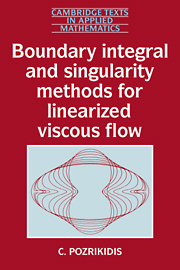7 - The singularity method
Published online by Cambridge University Press: 13 February 2010
Summary
Introduction
In the preceding chapters we developed integral representations of a flow in terms of boundary distributions of Green's functions and their associated stress tensor. Physically, these representations involve boundary distributions of point forces, point sources, and point force dipoles. When we applied the representations at the boundaries of the flow and imposed the required boundary conditions, we obtained Fredholm integral equations of the first or second kind for the unknown boundary functions. Two advantages of solving these equations instead of the primary differential equations are reduction of the dimensionality of the mathematical problem with respect to the physical problem by one unit, and efficient treatment of infinite flows.
Now, in section 6.5 we saw that one important aspect of the numerical treatment of the integral equations resulting from boundary integral representations is the accurate computation of the singular single-layer and double-layer integrals. True, the singularities of the corresponding kernels may be subtracted off or eliminated using a suitable identity or changing the variables of integration, but this places burdens on the computer implementation and increases the cost of the computations. One ad-hoc way to circumvent this difficulty is to move the pole of the Green's function and its associated stress tensor from the boundary D onto a surface exterior to the flow, as illustrated in Figure 7.1.1. Of course, this is an arbitrary remedy that lacks physical foundation, but nevertheless it appears worth consideration. Furthermore, taking this action one step further, we may replace the continuous surface distribution of the singularities with line or point-wise distributions.
- Type
- Chapter
- Information
- Publisher: Cambridge University PressPrint publication year: 1992



